Dashboard Reports -- Generate Summary Report
A dashboard Summary Report is generated on-screen and provides you with top-level and detail analytics on selected Page Titles, Resources, Banner Campaigns, and Email Campaigns.
Analytics for each section of the report (i.e. Page Titles, Resources, Banner Campaigns, and Email Campaigns) are downloadable, and more detailed User Level Reports can be run and downloaded as well.
This lesson provides details on how to generate a Summary Report, download details, and generate more in-depth User Level Reports for selected page titles, resources, banner campaigns, and newsletter campaigns.
GENERATE SUMMARY REPORT

1) Set the desired date range 2) then select page titles, resources, banner campaigns, and/or email campaigns you wish to pull analytics for.
3) Once all selections have been made and the date range set, select "Generate Summary Report".
When completed, the Summary Report will appear as shown in the screenshots below.
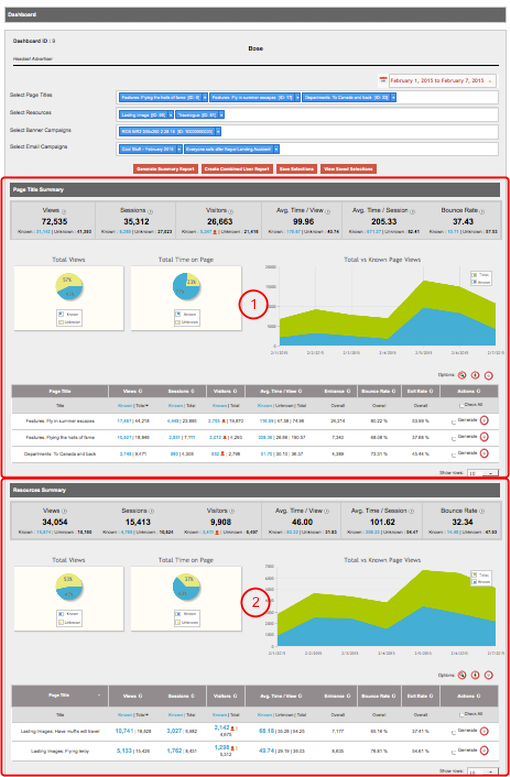
1 = Page Titles Summary
2 = Resources Summary
3 = Banner Campaign Summary
4 = Newsletter Campaign Summary
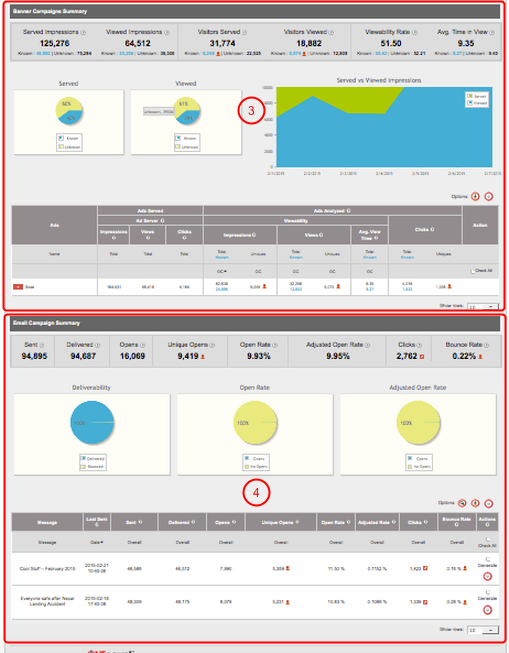
Summary Report Features and Options
The features and options described below are available for each of the four summaries (Page Titles, Resources, Banner Campaign, and Newsletter Campaign).
Show Rows
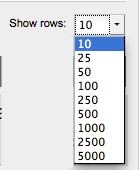
The default number of rows shown is 10. Use the drop-down menu to display more than 10 rows (up to 5,000).
You should select the appropriate number of rows to display whether or not you use either of the options described below (Refine Report, Download Report).
User Data Analysis

Clicking on this icon will bring you into the List Wizard where you can download the list of Known users, filter/segment the list further, and/or perform various administrative actions on the list. (See
List Wizard documentation for more information on functionality.)
Information

Clicking a " ? " in any table column heading will bring up a pop-up explaining the heading label. (See example below.)
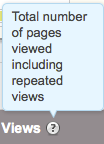
Options
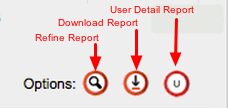
Refine Report
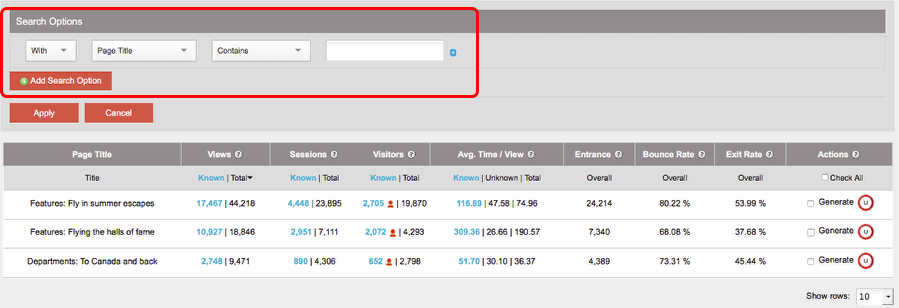
You can refine/filter your report by using the following search options and entering the value in the blank field:
With / Without > Page Title > Contains / Matches / Matches Exactly / Begins With / Ends With
With / Without > Views / Unique Views / Avg. Time on Page > Total / Known / Unknown > Equals / Greater Than / Less Than
With / Without > Entrance / Bounce Rate / Exit Rate > Equals / Greater Than / Less Than
For example, if you want to refine the report in the screenshot above to show only those resources/pages that begin with the word "Department" and that have 10,000+ Known page views, you would use the following options:
With > Page Title > Begns With > Departments
With > Page Views > Known > Greater Than > 10000 > Apply (See below.)
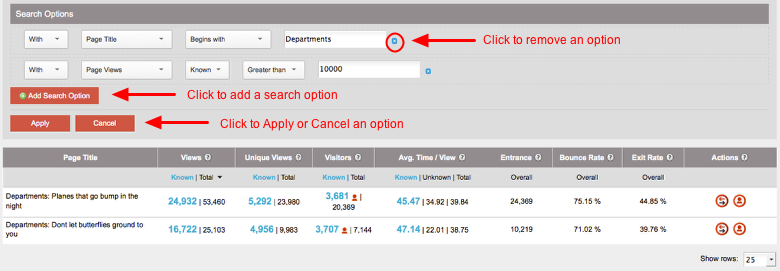
You may add multiple search options by clicking on the "Add Search Option" button. Multiple search options are joined by AND logic.
To remove an option, click on the blue "x" the right of the value field.
Note: When options are removed or cancelled, you must click on "Apply" again to refresh the report.
Download Summary Report
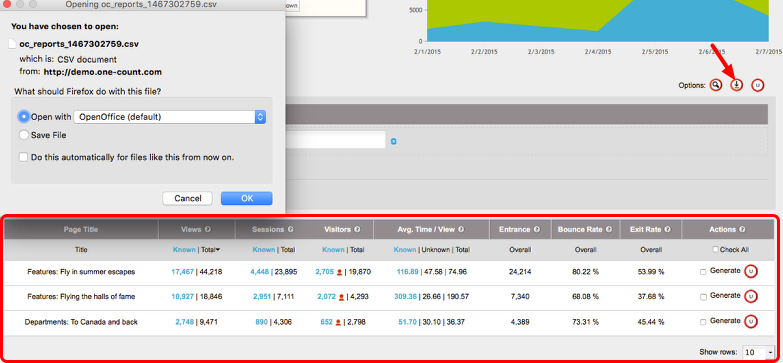
Downloading a report will download the report, as it is displayed, in .csv format.
If 25 rows are displayed, those 25 rows will be downloaded; if 50 rows are displayed, those 50 rows will be downloaded, etc.
USER DETAIL REPORTS
You can generate and download a User Detail report which provides demographic and activity detail for each known user who accessed selected pages, resources, or ads.
You can select one page title, resource, ad creative or newsletter campaign by clicking on the "U" icon in the Actions column of analytics detail. The report for a single selection varies slightly from a multiple-selection report.
Alternatively, you can make multiple page title, resource, ad creative, or newsletter campaign selections by clicking on the box beside "Generate" in the Actions column then selecting the "U" icon in the "Options" menu.
Single Selection User Detail Report

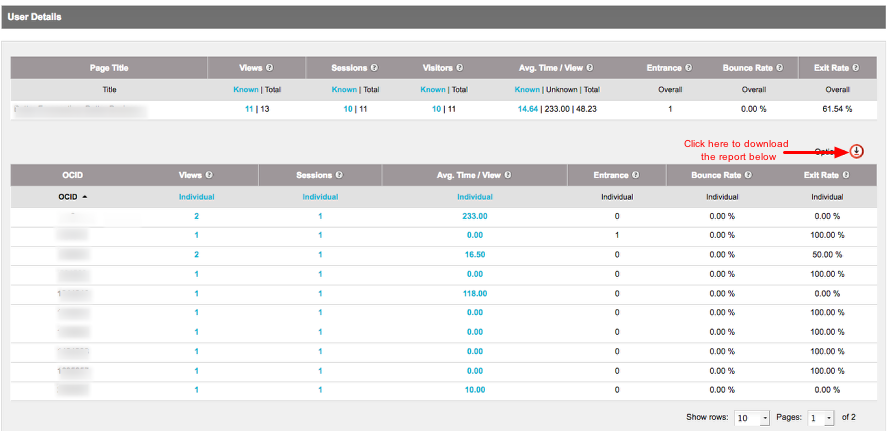
Because of limited screen space, the on-screen display of this report will show the only ocid and email (if email is selected as a demographic for the dashboard) and activity detail for each user. You can click on the download icon to download the report. On download any additional demographic questions that were assigned to the dashboard and selected in the Report Criteria Demographic Selection pop-up will be included. (See next two screenshots.)
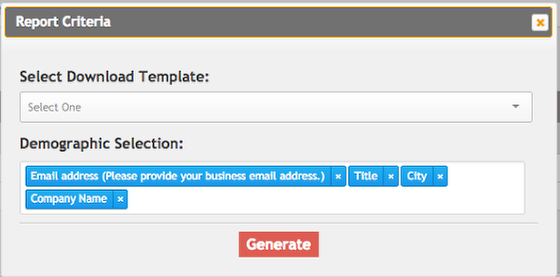
Note that Email address, Title, City, and Company Name were selected for download.

Note that Email Address, Title, City, and Company Name are shown in the downloaded report.
Multi Selection User Detail Report

Check the box beside "Generate" to select a resource(s) to report on or use the "Check All" box then select the "U" in the "Options" menu. (Not the "U" beside "Generate"; that produces a slightly different on-screen report that can be downloaded, as described above.)
You'll be presented with a pop-up screen where you can select a Download Template (optional) – created in the Question Builder module (see Question Builder documentation for more information), any additional demographic selections, and Consolidated or Individual report output.
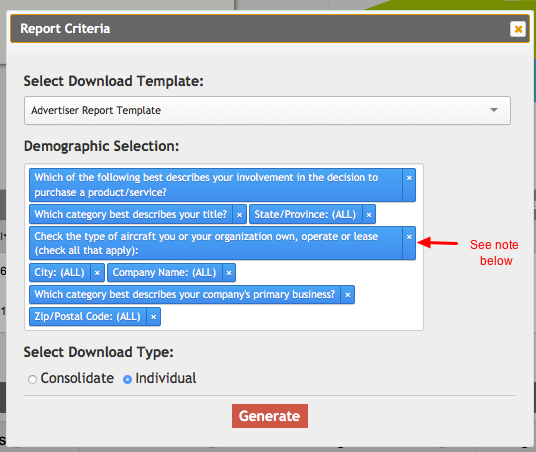
Note that while the question "Check the type of aircraft you or your organization own, operate or lease (check all that appy):" is included as a Report Criteria Demographic Selection, because that question was NOT included as a demographic when the dashboard was created, it does not appear on the output. Download of demographic data is restricted to only those demographic questions included on dashboard creation. (See screenshot below.)
Consolidated Multi-Selection User Detail Report

The Consolidated User Detail Report includes demographics and analytics on a per user basis for all page titles, resources,
Individual Multi-Selection User Detail Report

PAGE TITLE AND RESOURCES SUMMARIES
Statistics for Page Title Summary and Resources summary are the same.
Numbers 1-6 in the screenshots below represent totals for all selected pages/resources; i.e. if you selected five pages/resources when running the dashboard, these numbers (total, known, unknown) are totals for all five of them.
Numbers 7 and 8 represent percentages of Known and Unknown Views and Time on Site (totals for all selected pages/resources).
Number 9 is the detail for each page/resource selected, i.e. if two pages and/or two resources were selected, this table will show statistics 1-6 for each individual selection.
Note that the "User Data Analysis" icon appears next to the Known count of Visitors. Clicking on this icon will bring up the Report Criteria pop-up where you can select a download template (see Question Builder documentation for more detail on creting download templates) and/or additional demographic fields. The demographic fields for selection will be restricted to those assigned to the dashboard when it was created.
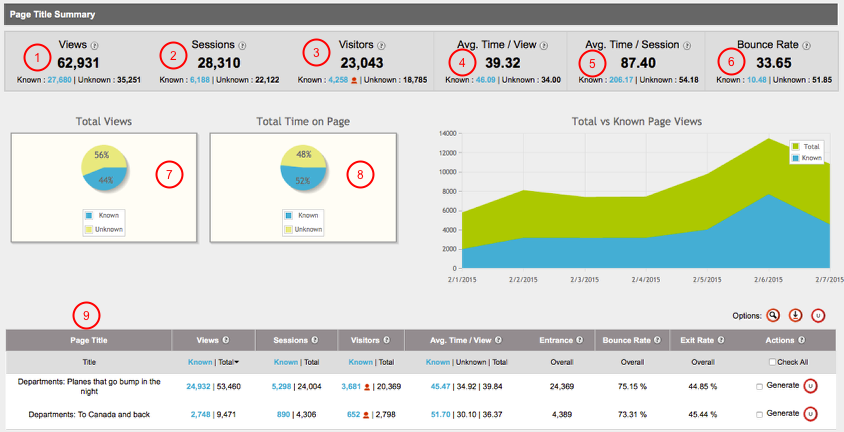
Resource - A resource is an identified and/or protected digital asset. A resource can be a web page or section of your website (such as a video library), e-newsletter, or file (a whitepaper, e.g.). Once a resource is attached to a product, that resource will be protected; and to access the resource, users will need to subscribe to/register for/purchase the product. (More detail on products and resources can be found in the Inventory module documentation.) A resource can be created without being attached to a product, thus not requiring user subscription/registration/purchase to access the resource but allowing analytics for that resource only to be easily pulled
Known * - A user in your database who has been identified and authenticated by ONEcount.
- A user must be authenticated and identified by ONEcount to be counted as a Known user. There are different ways to be identified: 1) By logging into a web site (direct log-in or via a lookup form), 2) by clicking on a smartlink** in an email blast, 3) by completing a registration/subscription form for a product. Once authenticated and identified, a cookie will be set, allowing you to track a user's activities as a Known user. If a user is not logged in/identified, activities will be tracked as an Unknown user. Once the user is authenticated and identified, all of his/her activities (including past activities) will be moved from Unknown statistics to Known statistics.*
Unknown -* A user who has not been authenticated/identified by the ONEcount system. A user may be in your database but be an unkown if they haven't been authenticated by logging in, clicking on a smartlink in an email, or completing a subscription/registration form for a new product.
Total - Total number of Known and Unknown users.
Views - The total number of times the page/resource was viewed. This number includes multiple views by the same user.
Unique Views - The number of times the page was viewed, not including multiple views by the same user. The first view is the only view that is counted.
Sessions - A session starts when a visitor first interacts with the web site. In most case the interaction is the first page view by the visitor. Every time a user interacts with an element of the site (like an event, social interaction, or opens a new page) the expiration time is reset by adding on an additional 30 minutes from the time of that interaction. A session ends when the user does not interact with the site for 30 minutes. So, if a visitor visits the site then goes away and comes back 35 minutes later, the activity is counted as two sessons.
Visitors - The total number of unique visitors who visited the website(s). (See Page Visit definition above.) Unique refers to the user only being counted once, even if they visited the site multiple times.
Average Time/View - Total time spent on a page divided by the total of views of a page. This metric is presented in seconds.
*Average Time/Session - T*otal duration of all sessions (in seconds) / number of sessions.
Entrance - The number of visits starting on a particular page or content area of a website.
Bounce Rate - The percentage of visitors who exit the site from the landing page itself, i.e. they exit the site from the page they came in on without navigating to any other pages. Bounce Rate can be sitewide or for an individual page. The rate is the total number of bounces divided by the total number of sessions.
Exit Rate - The percentage of visitors exiting the site from a particular page after having navigated there from other pages. The rate is the total number of Exits divided by the total number of Views. Exit rate is calculated for every page separately because it is the prperty of an individual page independent of any other page in the site.
BANNER CAMPAIGNS SUMMARY
Numbers 1-6 in the screenshots below represent totals for all selected banner campaigns; i.e. if you selected five campaigns when running the dashboard, these numbers (total, known, unknown) are totals for all five of them.
Numbers 7 and 8 represent percentages of Known and Unknown Views for all served and viewable ads (totals for all selected campaigns).
Number 9 shows served v. viewed impressions.
Number 10 is detailed analytics for each selected campaign.
- Banner data is collected by your banner server, ONEcount, and MOAT (optional).
- Data from your ad server (OpenX/Revive or DFP) is pulled into ONEcount and displayed under "Ads Served" in the detail report.
- Data collected using the ONEcount widget and MOAT pixel (optional) data is displayed under "Ads Analyzed".
Note that the "User Data Analysis" icon appears next to the Known count of Visitors. Clicking on this icon will bring up the Report Criteria pop-up where you can select a download template (see Question Builder documentation for more detail on creating download templates) and/or additional demographic fields. The demographic fields for selection will be restricted to those assigned to the dashboard when it was created.
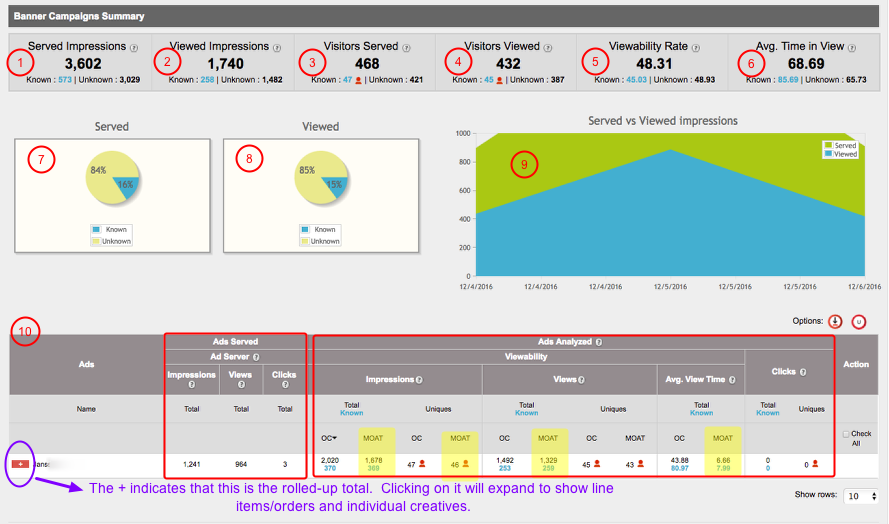
Notice the "MOAT" column in the Impressions, Views, and Avg. View Time columns. The MOAT column will only appear and populate if you are using MOAT and ONEcount has been configured to display the MOAT data.
If you do not use MOAT and/or your ONEcount system isn't configured to pull MOAT data in, you won't see a "MOAT" column. (See screenshot below.)
Clicking on the + icon beside the advertiser name will expand to show campaigns/orders, line items, and individual creatives for each selected banner campaign.
For DFP, the heirarchy is Advertiser, Campaign/Order, Line Item, Creative.
For OpenX/Revive, the heirarch is Advertiser, Campaign/Order, Creative. Because there are only 3 levels to this heirarchy (OpenX/Revive doesn't haveLine Item), the word "Default" will appear instead of the Line Item name. (See screenshot below.)
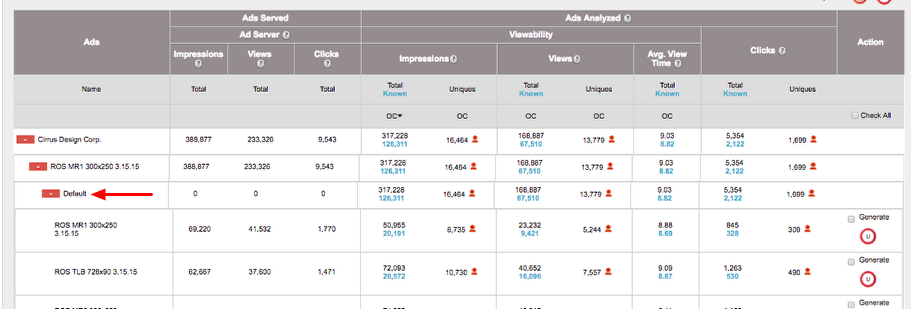
_Advertiser - _Advertiser(s) pulled from your ad serving platform. (ONEcount currently supports OpenX/Revive and DFP Premium/DFP Small Business.)
_Campaign - _Banner campaigns pulled from your ad serving platform. (ONEcount currently supports OpenX/Revive and DFP Premium/DFP Small Business.)
_Known -* _A user who is in the ONEcount system and has been authenticated and identified.
** A user must be authenticated and identified by ONEcount to be counted as a Known user. There are different ways to be identified: 1) By logging into a web site (direct log-in or via a lookup form), 2) by clicking on a smartlink** in an email blast, 3) by completing a registration/subscription form for a product. Once authenticated and identified, a cookie will be set, allowing you to track a user's activities as a Known user. If a user is not logged in/identified, activities will be tracked as an Unknown user. Once the user is authenticated and identified, all of his/her activities (including past activities) will be moved from Unknown statistics to Known statistics.*
_Unknown _= Includes counts of those users who are not authenticated/have not been identified by the ONEcount system. A user may be in your database but be an unkown if they haven't been authenticated by logging in, clicking on a smartlink in an email, or completing a subscription/registration form for a new product.
_Total - _Total of both Known and Unknown users.
_Served Impressions - _Number of ads that have been served, whether in view or not when the web page is loaded. This number is calculated by ONEcount.
_Viewed Impressions - _ Number of "viewable" ads that have been served. This number is calculated by ONEcount.
Per the IAB standards on viewability, an ad is counted as "viewed" when the following criteria are met:
- Pixel Requirement: Greater than or equal to 50% of the pixels in the advertisement are on an in-focus browser tab on the viewable space* of the browser page, and
- Time Requirement: The time the pixel requirement is met is greater than or equal to one continuous second, post ad render.
*Viewable space, per IAB is: Advertisements and content associated with each page load can appear either within or outside the viewable space of the browser on a user's screen - i.e., that part of the page within the browser that a user can see. This is similar to the concepts once referred to as "above the fold" (i.e., within the viewable browser space) and "below the fold" (i.e. outside the viewable browser space).
_Visitors Served - _The number of known visitors who were served ads, viewable or not viewable per IAB standards. If a visitor is served multiple ads, it is counted as one visitor served.
_Visitors Viewed - _The number of known visitors who were served ads that meet the IAB standards on viewability. If a visitor is served multiple Viewable ads, it is counted as one visitor served.
_Ads Served - _The total number of ads served. This number is pulled directly from your ad serving platform. (ONEcount currently supports OpenX/Revive ad serving platform.)
_Clicks - _The number of ads that were clicked on.
_Viewability Rate - _Number of Viewed Impressions / number of Served Impressions.
_ **_
_Avg. Time in View (in seconds) - _The average time ads are in view. Calculated by number of seconds in view / number of Viewed Impressions.
IMPORTANT NOTE:
In order to identify users and track activity, widgets must be embedded on every page of your web site (placing them in the top-level template will accomplish this). These widgets, specific to your site(s), and directions for placement are provided in the Widget Builder. Please see Widget Builder documentation for moreinformation.
ONEcount Library/Tracker: This javascript snippet controls gating/access, cookie setting and does web tracking.
_Automation Widget: Automation scripts are snippets of javascript code that allow ONEcount to target actions (like ad target, popup target etc). This piece of javascript determines and outputs any automated action to the browser. _
_Noscript Tag: A noscript tag is needed to track requests when js is disabled. _
_Banner Trackers: Banner widgets are used to track and report banner activity. There are two banner platforms supported within ONEcount: OpenX and DFP (Premium and Small Business). _
_ Third Party Trackers Modifications: Usually websites will have third party trackers like Google Analytics, etc. installed on their website. A small piece of code needs to be added to those third party trackers so that ONEcount can pass the original referrer to those systems. We provide the code that needs to be added to your Google analytics code. If any other third party trackers are being used on your website, please let your ONEcount account manager know ahead of time. _
_ONEcount Pixel for Moat: ONEcount can collect ad viewability data from Moat's realtime pixel. In order to send data to ONEcount, Moat can fire a pixel like below to send data to ONEcount. _
EMAIL CAMPAIGNS SUMMARY
Numbers 1-8 in the screenshots below represent totals for all selected email campaigns; i.e. if you selected fivecampaigns when running the dashboard, these numbers are totals for all five of them.
Numbers 9-11 below represent percentages of delivered, opened (based on total sent), and adjusted opens (based on total delivered).
Number 12 is the detail for each campaign selected, i.e. if two campaigns were selected, this table will show statistics 1-8 for each individual selection.
Note that the "User Data Analysis" icon appears next to the Known count of Visitors. Clicking on this icon will bring up the Report Criteria pop-up where you can select a download template (see Question Builder documentation for more detail on creting download templates) and/or additional demographic fields. The demographic fields for selection will be restricted to those assigned to the dashboard when it was created.
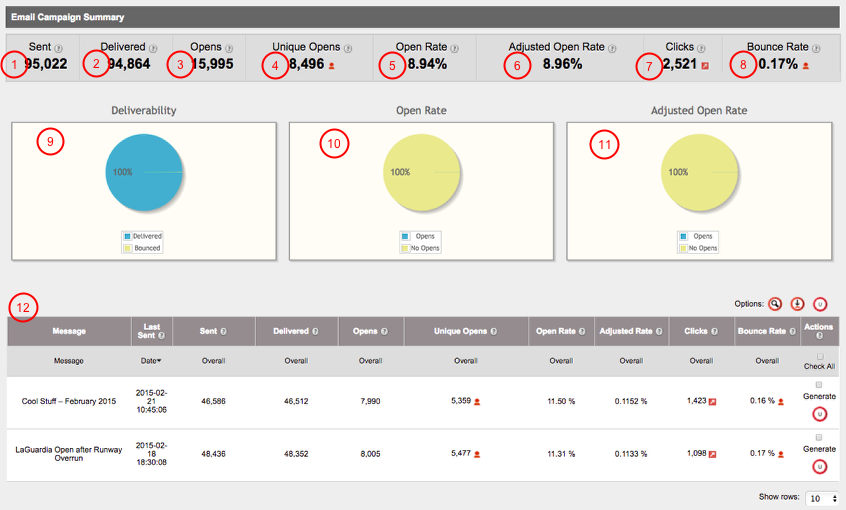
_Known -* _A user who is in the ONEcount system and has been authenticated and identified.
** A user must be authenticated and identified by ONEcount to be counted as a Known user. There are different ways to be identified: 1) By logging into a web site (direct log-in or via a lookup form), 2) by clicking on a smartlink** in an email blast, 3) by completing a registration/subscription form for a product. Once authenticated and identified, a cookie will be set, allowing you to track a user's activities as a Known user. If a user is not logged in/identified, activities will be tracked as an Unknown user. Once the user is authenticated and identified, all of his/her activities (including past activities) will be moved from Unknown statistics to Known statistics.*
_Unknown _= Includes counts of those users who are not authenticated/have not been identified by the ONEcount system. A user may be in your database but be an unkown if they haven't been authenticated by logging in, clicking on a smartlink in an email, or completing a subscription/registration form for a new product.
_Total - _Total of both Known and Unknown users.
_Sent - _The total number of emails sent.
_Delivered - _The total number of emails delivered.
_Opens - _The total number of emails opened, including multiple opens by the same user.
_Unique Opens - _The number of the distinct recipients that have opened your campaign, i.e. if John Doe opens an email four times, all four will be counted under "Opens" but only one will be counted under "Unique Opens".
_Open Rate - _The total number of opens divided by the total number sent.
_Adjusted Rate - _The total number of opens divided by the total number delivered.
_Clicks - _The total number of clicks.
_Bounce Rate - _ Percentage of bounced emails.
Search all Documentation:
Unknown macro: livesearch. Click on this message for details.
The [livesearch] macro is not in the list of registered macros. Verify the spelling or contact your administrator.
Search Dashboards Documentation:
Unknown macro: pagetreesearch. Click on this message for details.
The [pagetreesearch] macro is not in the list of registered macros. Verify the spelling or contact your administrator.
Click here to expand...
More Dashboards Documentation
Search all Documentation:
Unknown macro: livesearch. Click on this message for details.
The [livesearch] macro is not in the list of registered macros. Verify the spelling or contact your administrator.
Search Dashboards Documentation:
Unknown macro: pagetreesearch. Click on this message for details.
The [pagetreesearch] macro is not in the list of registered macros. Verify the spelling or contact your administrator.
More Dashboards Documentation
Run Dashboard – Select, Save, View, and Use Saved Selections
Dashboard Reports - Combined User Report
Dashboard Reports - Create Feed Report
